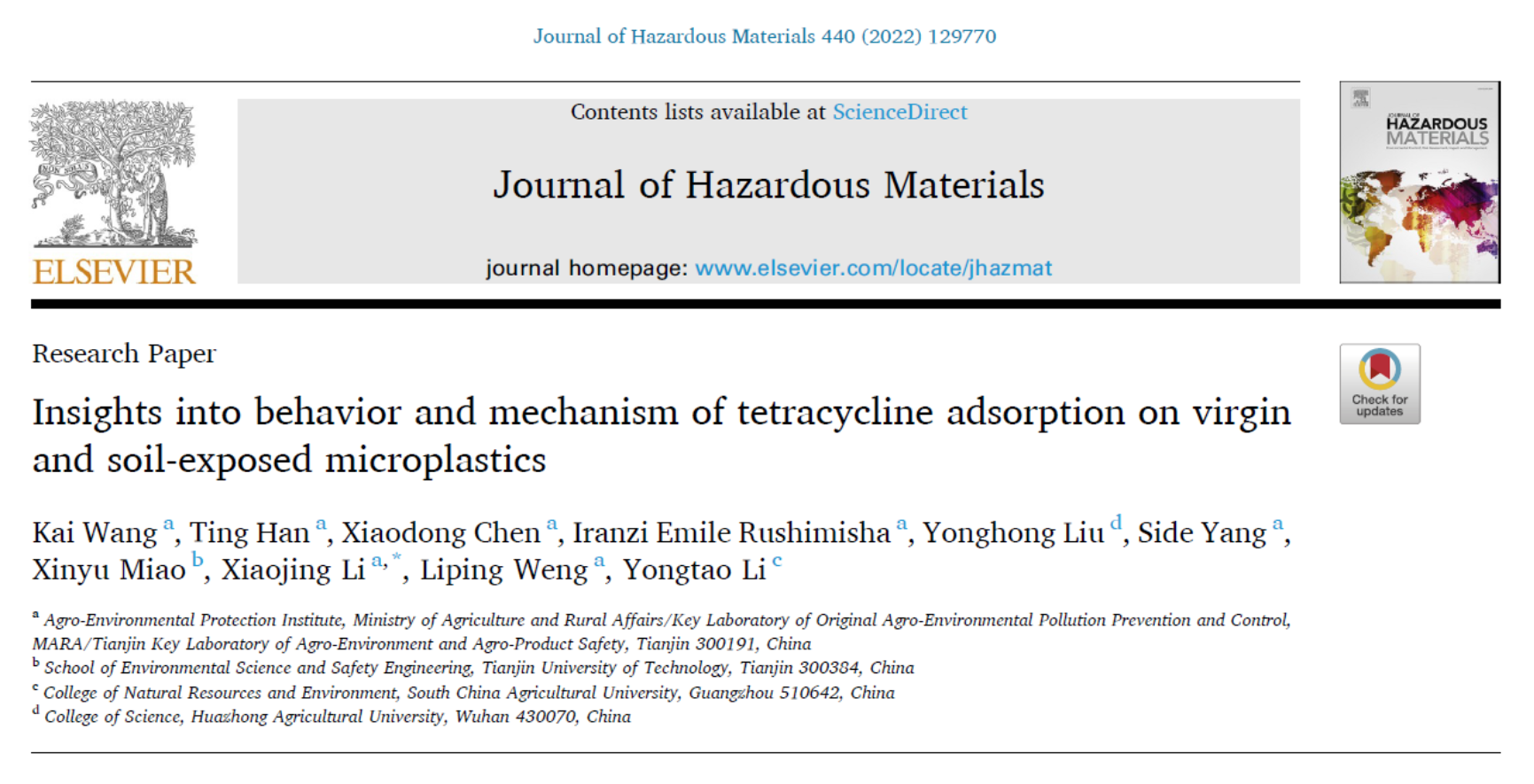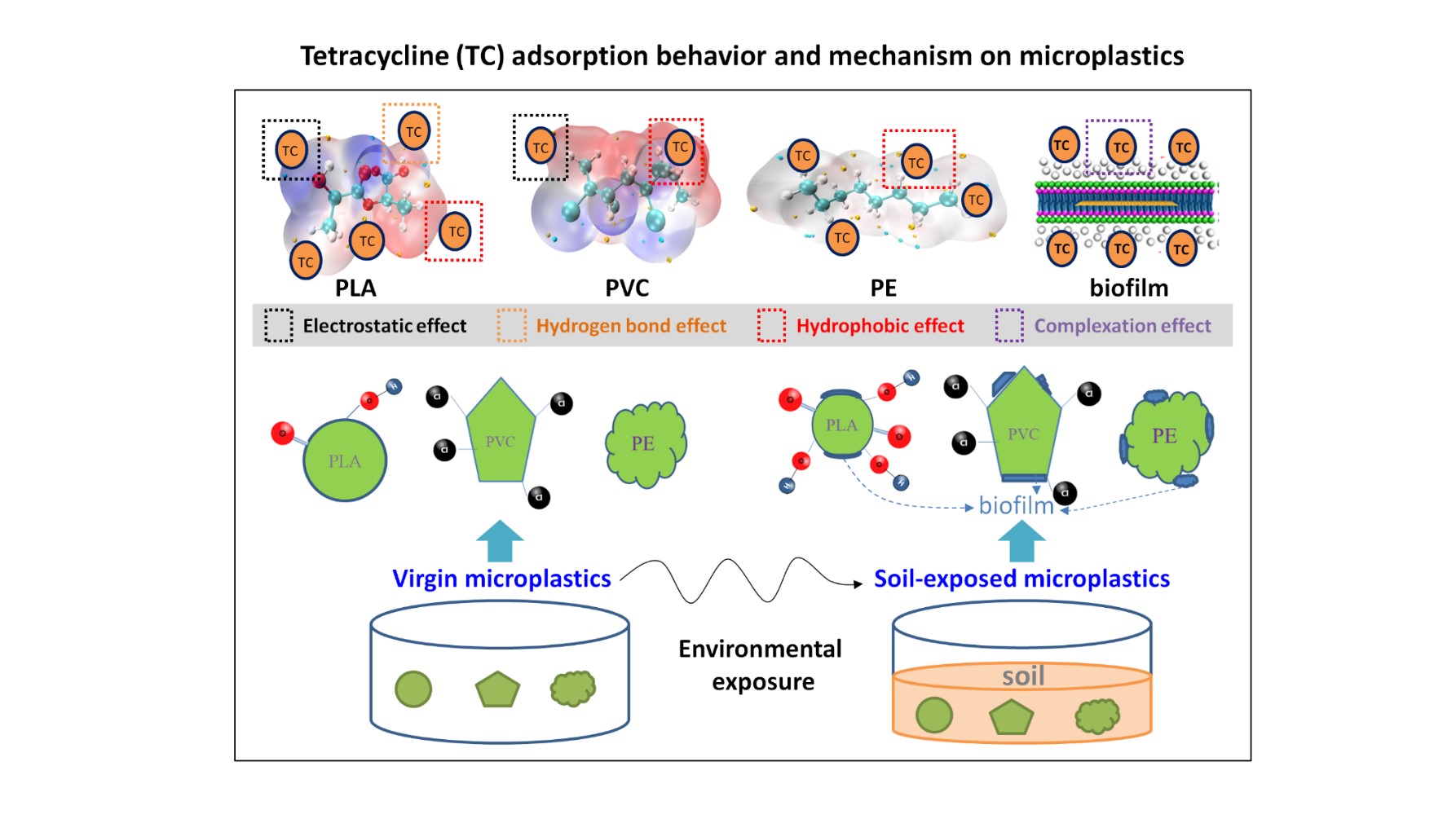Journal of Hazardous Materials: 揭示土壤老化的微塑料对四环素的吸附机制
作者: 来源:农田有机污染生物消减创新团队 2022-10-21
Journal of Hazardous Materials: 揭示土壤老化的微塑料对四环素的吸附机制

近日,农业农村部环境保护科研监测所农田有机污染生物消减创新团队在Journal of Hazardous Materials上发表了题为“Insights into behavior and mechanism of tetracycline adsorption on virgin and soil-exposed microplastics”的研究论文。本研究探究了原始塑料和土壤暴露塑料对水环境中四环素的吸附效果,主要采用聚乙烯(PE)、聚氯乙烯(PVC)、聚乳酸(PLA)为研究对象,研究了不同塑料对四环素的吸附机制,研究结果为土壤环境中有机污染物在环境暴露的塑料表面的吸附行为提供了新的见解。
农业农村部环境保护科研监测所博士研究生王凯为论文第一作者,李晓晶研究员为论文通讯作者。研究工作得到了国家自然科学基金(41977133和41601536)、天津市自然科学基金(20JCYBJC01590)、农业农村部环境保护科研监测所基础前沿任务和创新工程所级重点项目资助。
DOI: 10.1016/j.jhazmat.2022.129770
Highlights
•The adsorption of TC on PE and PVC was determined by the hydrophobicity.
•Biofilm colonization on MPs surface increased the adsorption capacity of TC.
•The soil DOM extraction facilitated the desorption of TC from MPs.
•Soil-exposed MPs showed the potential to promote the degradation of TC.
•The soil-exposed PLA promoted the formation of hydrogen bonds with TC.
Abstract
Microplastics (MPs), as vectors of pollutants, have attracted extensive attention because of their environmental effects. However, the adsorption behavior and antibiotic mechanism of environmentally exposed MPs is limited. Here, the adsorption of tetracycline(TC) onto virgin and soil-exposed polylactic acid(PLA), polyvinyl chloride(PVC) and polyethylene(PE) MPs showed that the adsorption capacity of MPs for TC increased after soil exposure, and PLA showed the strongest increase. Soil exposure increased the time to reach equilibrium, and the adsorption rate was controlled by both intraparticle diffusion and membrane diffusion. The isothermal adsorption results of soil-exposed PE and PLA indicated that TC adsorbed on heterogeneous surfaces was affected by the physicochemical adsorption process. The equilibrium absorption capacity of MPs for TC increased by 88% (PLA), 26% (PVC) and 15% (PE) after soil exposure. Soil dissolved organic matter promoted the desorption of TC from MPs, and TC speciation changed with pH. Soil-exposed MPs have the potential to promote TC degradation in solution without the addition of biological inhibitors. Moreover, density functional theory calculations verified that PE and PVC adsorbed TC through physical interactions, while hydrogen bonds were formed on PLA with TC. These results clarified the behavior and mechanisms of TC adsorption on virgin and soil-exposed MPs, which can help in the risk assessment of concomitant pollution of MPs and antibiotics.

由于其体积小、表面积大和疏水性强等特性,微塑料(MPs)可作为许多有机污染物的汇,如多环芳烃、多氯联苯、药品和个人护理产品,并进一步充当污染物迁移的载体。然而,一旦MPs进入环境,它们就容易受到各种非生物和生物过程的影响。首先,置于土壤环境MPs(S-MPs)在长期风化、紫外线辐射和土壤微生物定殖的影响下容易发生表面转化。其次,土壤中各种离子和DOM往往通过物理和化学反应与有机污染物(OPs)竞争或共吸附。除了暴露在水和土壤中的MPs所经历的表面性质变化外,MPs还可以构成一个类似于“根际”的生态位,称为“塑料圈”。土壤环境可能影响塑料废弃物对OPs的吸附,而且MPs对环境暴露的响应与塑料的类型密切相关,因此有必要阐明环境暴露的MPs和OPs之间的相互作用。
MPs作为污染物的载体,因其对环境的影响而受到广泛关注。然而,对环境暴露的MPs与有机污染物的相互作用机制的了解有限。聚乳酸(PLA)、PVC和PE MPs对四环素(TC)的吸附表明,暴露于土壤后,MPs对TC的吸附能力增加,其中PLA的增加最显著。土壤暴露增加了达到吸附平衡的时间,吸附速率受颗粒内扩散和膜扩散控制。暴露于土壤中的PE和PLA的等温吸附结果表明,TC在非均质表面的吸附受物理化学吸附过程的影响。土壤暴露后,MPs对TC的平衡吸收能力分别提高88% (PLA)、26% (PVC)和15% (PE)。土壤溶解性有机质(DOM)促进了TC从MPs表面解吸,且TC的形态随pH的变化而变化。在不添加生物抑制剂的情况下,土壤暴露的MPs具有促进溶液中TC降解的潜力。密度泛函理论(DFT)计算证实PE和PVC主要通过物理作用吸附TC,而PLA则可以通过与TC形成氢键促进吸附(图1)。这些结果阐明了TC在原始和土壤暴露的MPs上的吸附行为和机制,有助于对MPs和抗生素的复合污染进行风险评估。

图1 TC (a)、PE (b)、PVC (c)、PLA (d)的表面静电势(kcal/mol)分布;TC和PLA的范德华力穿透(e);最大范德华力穿透点位置(f);结构优化后PLA和TC间形成的氢键(g)。













